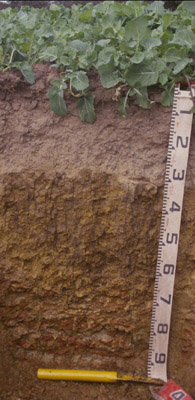SFS 19
Location: Teesdale-Inverleigh Road
Aust. Soil Class.: Vertic (& Ferric), Mottled-Subnatric, Brown SODOSOL
General Landscape Description: Level Plain
Site Description: "Leigh Road South Paddock”
Landform: Level plain
Element: Plain
Slope: 0-1%
Aspect: 0
Geology: Moorabool Viaduct
 SFS 19 |
Soil Profile Morphology:
| Surface Soil |  SFS 19 | ||
| Ap | 0-10 cm | Dark brown (10YR 3/3); light sandy loam; weakly pedal structure tending to platy at bottom of Ap; weak consistence; pH 6.3; clear change to: | |
| A2c | 10-30 cm | Yellowish brown (10YR 5/4 moist) conspicuously bleached (10YR 6/3 dry); gravelly loam; apedal structure; weak consistence; very many (>50%) medium to coarse (5-20 mm) irregular sub-rounded gravel - mostly cemented ferruginous nodules (remnants of Moorabool Viaduct sand) but also minor component of rounded quartz alluvial gravel; pH 5.1; sharp and smooth change to: | |
| Subsoil | |||
| B21t | 30-60/70 cm | Brown (10YR 5/3) clay ped exteriors (thick cutans) surrounding brownish yellow (10YR 6/8) matrix with reddish yellow (7.5YR 6/8) mottles; medium clay; coarse (<60 mm) prismatic, parting to medium to coarse blocky (10-40 mm) and fine to medium (<15 mm) polyhedral and lenticular structure; strong consistence; slickensided appearance to most of the ped fractures; pH 6.7; clear change to: | |
| B/C | 60/70+ cm | Mottled dark red (10R 3/6) to red (10R 5/8) with reddish yellow (7.5 YR 6/8) and grey (2.5Y 7/1) coarse mottling; weathered ferruginised Moorabool Viaduct Formation sediments with clay accumulation; rigid ferruginised masses of sandier material than B21 above but with reticulate structure defined by thick bands of illuviated clay; pH 7.6. | |
Key Profile Features:
- Strong texture contrast between surface (A) horizon and subsoil (B21) horizon.
- Conspicuously bleached subsurface (A2) horizon with ferruginous nodules.
Soil Profile Characteristics:
pH | Salinity Rating | |||
Surface (A1 horizon) | Slightly Acid | Low | Non-Sodic | None |
Subsoil (B21 horizon) | Slightly Acid | Very Low | Marginally Sodic | Moderate-Strong |
Deeper subsoil (at 1 m) | Slightly Alkaline | Very Low | Sodic |
 |
Horizon | Horizon Depth (cm) | pH (water) | pH (CaCl2) | EC dS/m | NaCl | Exchangeable Cations | |||
Ca | Mg | K | Na | ||||||
meq/100g | |||||||||
AP | 0-10 | 6.3 | 6.1 | 0.22 | 3.3 | 0.7 | 0.5 | <0.1 | |
A2 | 15-30 | 5.1 | 4.5 | 0.05 | 0.88 | 0.25 | 0.24 | 0.24 | |
B21+ | 40-60 | 6.7 | 6.2 | 0.15 | 5.4 | 7.9 | 1.4 | 1.4 | |
C/B | 80+ | 7.6 | 6.8 | 0.12 | 2.8 | 5.7 | 0.45 | 0.45 | |
Horizon | Horizon Depth (cm) | Exchangeable Aluminium mg/kg | Exchangeable Acidity meq/100g | Field Capacity pF2.5 | Wilting Point pF4.2 | Coarse Sand (0.2-2.0 mm) | Fine Sand (0.02-0.2 mm) | Silt (0.002-0.02 mm) | Clay (<0.002 mm) |
AP | 0-10 | <10 | 6.9 | 10.4 | 6.4 | 60.4 | 23.8 | 3.0 | 7.5 |
A2 | 15-30 | 18 | 3.7 | 7.0 | 2.6 | 58.7 | 28.5 | 4.0 | 6.0 |
B21+ | 40-60 | <10 | 8.8 | 50.4 | 30.3 | 6.4 | 2.6 | 2.5 | 86.0 |
C/B | 80+ | 30.2 | 19.9 | 23.4 | 10.2 | 6.0 | 58.5 |
Management Considerations:
- The three profiles shown here represent well the variation over short distances (within farm or paddock) for soils developed on the Moorabool Viaduct formation sediments.
- The texture contrast and the sodic subsoil restricts drainage and the soils readily become waterlogged in winter.
- The sandy topsoils are very susceptible to soil structure decline; the weak aggregation is readily destroyed by cultivation and the soils are prone to compaction. Bare soil is vulnerable to structural breakdown by rain (slaking and sealing) and to erosion by water. In dry conditions these soils are known to be vulnerable to wind erosion.
- Plough pans are common in these soils. Disruption of pans by tillage is short lived unless controlled traffic is deployed in cropping situations. Raised beds have been used with some degree of success in these soils but the unstable topsoils do not lend themselves well to bed survival.
- Two additional sites were excavated in the vicinity.
- Soil profile described by Richard MacEwan & Mark Imhof, June 2000.


